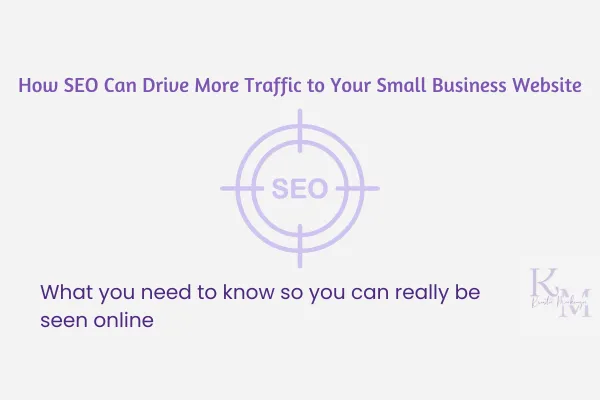
How SEO Can Drive More Traffic to Your Small Business Website
It's important to look beyond rankings and rather ensure a website is useable for everyone. - Ruth Everett
having a well-designed website is only half the battle for small businesses. To truly stand out, you need to ensure that potential customers can find you online. That’s where Search Engine Optimisation (SEO) comes in. By optimising your website for search engines, you can increase visibility, drive more traffic, and ultimately grow your business. In this post, we’ll explore how SEO can help your small business website attract more visitors and generate more leads.
What is SEO and Why Does It Matter?
SEO is the process of optimising your website so that it ranks higher on search engines like Google. When your website ranks higher, it becomes more visible to potential customers who are searching for the products or services you offer. For small businesses, this can mean the difference between getting lost in the competition or standing out as a go-to solution.
SEO is essential because:
93% of online experiences begin with a search engine.
Websites that appear on the first page of search results get over 70% of clicks.
SEO not only drives traffic but also brings in qualified leads, meaning visitors are more likely to become customers.
Key SEO Strategies for Driving Traffic
Optimise for Keywords
Keywords are the backbone of SEO. By conducting thorough keyword research, you can identify the terms your potential customers are searching for. Use tools like Google’s Keyword Planner to find high-volume, low-competition keywords relevant to your industry. Once identified, incorporate these keywords naturally into your website’s content, titles, and meta descriptions. This helps search engines understand what your business is about and match your site to relevant searches.Create High-Quality Content
Content is king when it comes to SEO. Regularly publishing valuable, SEO-optimised content—whether through blog posts, product pages, or service descriptions—can significantly improve your search rankings. Content marketing drives organic traffic by answering users’ questions and providing solutions. Make sure your content is engaging, informative, and includes targeted keywords to attract search engine algorithms.Optimise On-Page Elements
On-page SEO refers to the elements on your website that you can control. This includes optimising page titles, headers, meta descriptions, and URLs. Ensure each page has a unique title that includes a focus keyword and write clear, concise meta descriptions that encourage users to click through. Don’t forget about alt text for images, as this also contributes to your website’s overall search-ability.Build Backlinks
Backlinks (links from other reputable websites) are a crucial part of SEO. Search engines see backlinks as a vote of confidence in your website’s content. The more quality backlinks you have, the higher your website is likely to rank. For small businesses, this can be achieved through guest blogging, partnering with influencers, or collaborating with local businesses to exchange links.Improve Page Speed and Mobile Friendliness
Website performance plays a significant role in your SEO ranking. Search engines prioritise websites that load quickly and offer a seamless experience on both desktop and mobile devices. Make sure your website is optimised for mobile responsiveness and has fast loading times. Google offers free tools like PageSpeed Insights to help you identify areas where you can improve your site’s performance.Leverage Local SEO
For small businesses, local SEO is an invaluable tool for attracting nearby customers. Make sure your business is listed on Google My Business, and include accurate NAP (Name, Address, Phone Number) information across your website and other online listings. Use location-specific keywords, such as “coffee shop in Hawthorn,” to capture local search traffic.Monitor and Adjust Your SEO Strategy
SEO is not a one-time task—it requires ongoing effort and adjustments. Regularly monitor your website’s performance using tools like Google Analytics and Google Search Console. Track keyword rankings, organic traffic, and user behaviour to see what’s working and where improvements can be made. By analysing data and tweaking your strategy, you can continually drive more traffic to your website.
How SEO Drives Long-Term Results
One of the biggest advantages of SEO is its long-term impact. While it may take time to see significant results, once your small business website is optimised, the benefits continue to grow. With consistent SEO efforts, you can:
Build a stronger online presence.
Increase organic traffic without paying for ads.
Improve user experience through faster load times and quality content.
Generate leads and sales from a more engaged audience.
SEO doesn’t just drive traffic—it brings in qualified leads who are actively searching for the products and services your small business provides.
SEO is Essential for Small Business Growth
For small businesses, SEO is not just an option—it’s a necessity. By focusing on keyword optimisation, creating quality content, building backlinks, and enhancing your website’s performance, you can increase traffic and visibility for your small business. SEO requires time and effort, but the rewards are significant: better rankings, more traffic, and a steady stream of new customers.
Ready to optimise your website and start driving more traffic? Contact us today to learn how we can help your small business succeed through a comprehensive, tailored SEO strategy.
